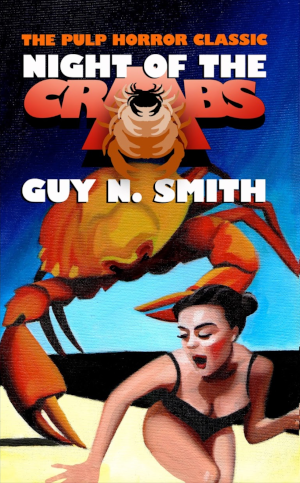
Summer of ’76. A scorching heatwave hits Britain and holidaymakers flock to the beautiful Welsh coast for sun, sea and sand. But something is terribly wrong. When bathers start disappearing, marine biologist Professor Cliff Davenport discovers giant crabs lurking in the deep. Giant crabs hellbent on destruction. Can Davenport and the military annihilate these monstrous crustaceans before they extinguish humankind? Or is mass mutilation just a pincer-grip away? By the time you hear clickety-click…it’s already too late.
Night of the Crabs is Guy N. Smith’s iconic pulp horror hit of the 1970s.
Plot Summary
The story is set along the Welsh coastline, where a series of mysterious disappearances and violent deaths alarm the local community. The protagonist, marine biologist Cliff Davenport, is drawn into the investigation when his nephew and the nephew’s girlfriend go missing while vacationing near the sea.
Davenport discovers that giant, carnivorous crabs are responsible for the attacks. These crabs, far larger and more aggressive than any known species, have been driven ashore by a combination of environmental changes and human activities. The crabs are not only deadly but seemingly impervious to conventional weapons.
As the crabs wreak havoc on the coastline, Davenport teams up with local authorities and military forces in a desperate attempt to stop the onslaught. The novel builds to a climax as they face the terrifying reality of the crabs’ breeding ground and the potential for an even greater disaster.
Themes and Style
- Nature’s Revenge: The novel reflects themes of nature striking back against human encroachment and exploitation.
- Survival Horror: Smith effectively creates a sense of urgency and fear, as characters must fight for their lives against an unstoppable force.
- Environmental Catastrophe: The book touches on ecological themes, highlighting how environmental disruption can lead to unforeseen and disastrous consequences.
Reception
“Night of the Crabs” was well-received by fans of horror and pulp fiction, praised for its fast-paced, action-packed narrative and its ability to deliver genuine thrills. The success of the novel led to a series of sequels, making the giant crabs a recurring threat in Smith’s body of work.
Sequels and Legacy
The popularity of “Night of the Crabs” spawned several sequels, including:
- “Killer Crabs” (1978)
- “The Origin of the Crabs” (1979)
- “Crabs on the Rampage” (1981)
- “Crabs’ Moon” (1984)
- “Crabs: The Human Sacrifice” (1988)
- “Killer Crabs: The Return” (2012)
These books expanded on the original story, exploring new settings and escalating the threat posed by the giant crabs. The series has maintained a cult following, appreciated for its blend of horror, adventure, and sheer courageousness.
By 1975 I had achieved my ambition to become a professional author and that year I left my job in banking to go full time. It was a nail-biting move, though, and my main concern was for the future. Would it be sufficient to provide an income which would sustain a wife and three children? Angus, our fourth child, was born in 1976.
I had already submitted the manuscript for “Night of the Crabs” to New English Library but they had not advised me of their publishing plans except that it was due to be released in the summer of 1976.
In July that year we went on holiday to Barmouth where the book was set. So, one balmy evening we were meandering through the town where most of the shops were still open. Gavin, our eldest son, wandered into W.H. Smith’s and suddenly there was a loud shout from him that had heads turning. “Dad, they’ve got hundreds of your books in here!”
So it was. A major in-store display on shelves and a central revolving rack labelled “The No.1 Beach read.”
The shop manager approached me, enquired if I was the author, and then asked if I could possibly do a signing session – there and then! The outcome was that I ended up sitting at a table inside the doorway signing copies for a seemingly endless queue of buyers.
That was just the start. “Night of the Crabs” was on sale just about everywhere, had already been reprinted before publication, and saw 9 subsequent reprints and a number of foreign translation rights sold. Four months later the movie rights were purchased by Amicus.
A year later I fulfilled another of my ambitions, selling our house in Tamworth and moving to Black Hill, a remote area of the Shropshire/Welsh border hills where I already had the shooting rights and had been travelling here for the past 14 years.
Guy N. Smith